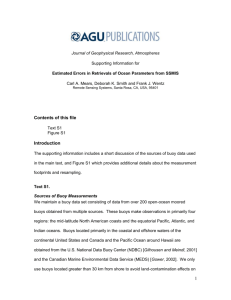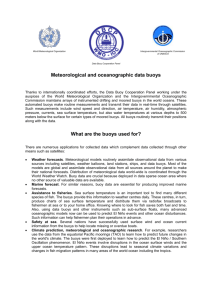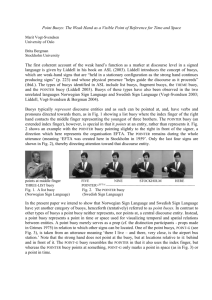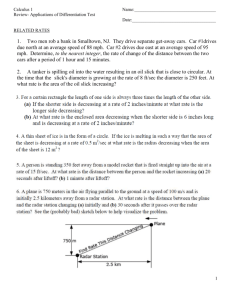ISPOL Drifting Buoy Data Report
advertisement
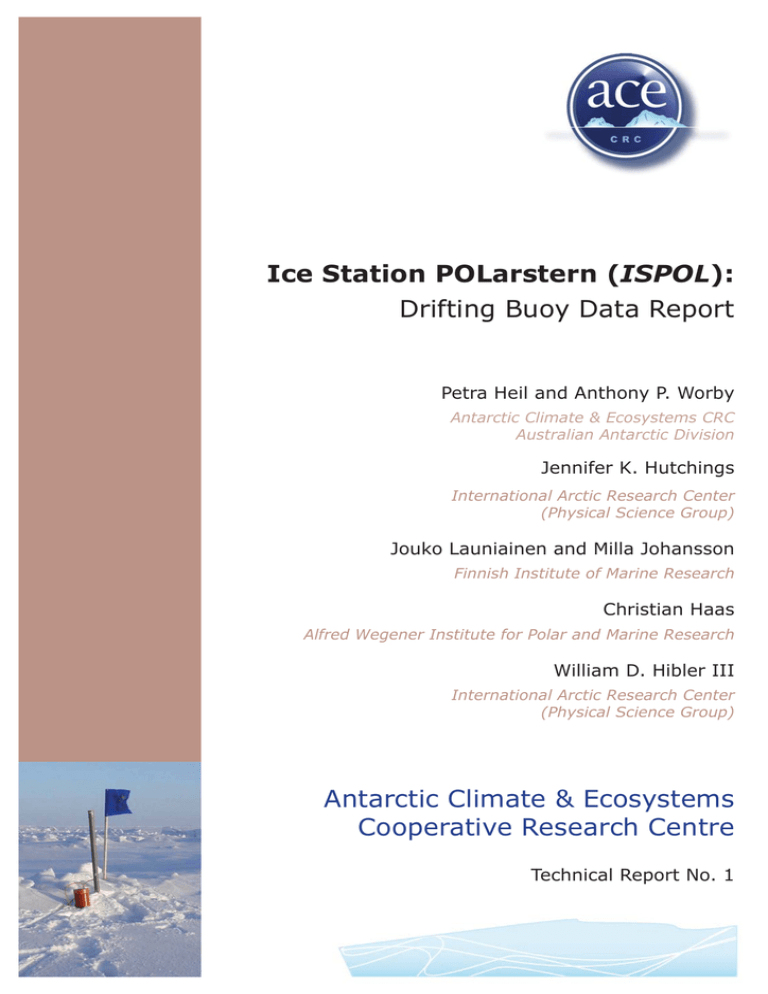
Ice Station POLarstern (ISPOL): Drifting Buoy Data Report Petra Heil and Anthony P. Worby Antarctic Climate & Ecosystems CRC Australian Antarctic Division Jennifer K. Hutchings International Arctic Research Center (Physical Science Group) Jouko Launiainen and Milla Johansson Finnish Institute of Marine Research Christian Haas Alfred Wegener Institute for Polar and Marine Research William D. Hibler III International Arctic Research Center (Physical Science Group) Antarctic Climate & Ecosystems Cooperative Research Centre Technical Report No. 1 Petra Heil and Anthony P. Worby Antarctic Climate & Ecosystems CRC Australian Antarctic Division University of Tasmania Private Box 80 Hobart, Tasmania 7050, Australia. email: petra.heil@utas.edu.au email: a.worby@utas.edu.au Jennifer K. Hutchings International Arctic Research Center (Physical Science Group) University of Alaska, Fairbanks 930 Koyukuk Dr., P.O. Box 757335 Fairbanks, Alaska 99775-7320, USA. email: jenny@iarc.uaf.edu Jouko Launiainen and Milla Johansson Finnish Institute of Marine Research P.O. Box 33 FIN-00931 Helsinki, Finland. email: jouko.launiainen@fimr.fi email: milla.johansson@fimr.fi Christian Haas Alfred Wegener Institute for Polar and Marine Research Postfach 120161 27515 Bremerhaven, Germany. email: chaas@awi-bremerhaven.de William D. Hibler III International Arctic Research Center (Physical Science Group) University of Alaska, Fairbanks 930 Koyukuk Dr., P.O. Box 757335 Fairbanks, Alaska 99775-7320, USA. email: billh@iarc.uaf.edu © Cooperative Research Centre for Antarctic Climate & Ecosystems 2005 ISSN: 1833-2404 ISBN: 1-921197-00-5 November 2005 Published by The Antarctic Climate & Ecosystems Cooperative Research Centre, Hobart, Tasmania, Australia, 20 pp. Established and supported under the Commonwealth Governments Cooperative Research Centres Programme. Ice Station POLarstern (ISPOL): Drifting Buoy Data Report Contents Background and scientific objectives Deployment overview Site revisits Recovery overview Data availability Instrument overview Horizontal accuracy of ISPOL buoys Intercomparison of atmospheric data collected by ISPOL buoys Post ISPOL sea ice drift observations Acknowledgements References Appendix I: Data products Appendix II: Photo gallery 4 5 8 8 8 11 12 13 16 17 17 18 19 Figures Figure Figure Figure Figure Figure Figure Figure Figure Figure Figure Figure 2: ISPOL buoy array plus the remote Finnish buoy 3: Buoys in the Western Weddell Sea, 28 Nov. 2004 to 01 Jan. 2005 4: Two FIMR buoys with meteorological sensors before deployment 5: Buoys prior to deployment for calibration of meteorological sensors 6: Intercomparison of atmospheric pressure 7: Intercomparison of surface air temperature 8: Drift of four remaining buoys from late Dec. 2004 to mid June 2005 9: FIMR buoys: Buoys 1154 and 5892 10: AAD buoys: MetOcean buoy 20141 and Clearwater buoy 19035 11: AWI buoys: Buoys 14955 and 9803 12: IARC buoys: SiteM and buoy 5359 5 10 11 12 14 15 16 19 19 19 20 Tables Table Table Table Table Table Table 1: 2: 3: 4: 5: 6: Information on the deployment of the ISPOL sea ice buoys Information on the recovery of the ISPOL sea ice buoys Ice-floe revisits for ISPOL sea ice buoys Data availability and sampling frequencies for the ISPOL buoys Buoy manufacturers, GPS systems and nominal accuracy, sensors Component and total horizontal position accuracy for ISPOL buoys 6 7 8 9 11 13 Antarctic Climate & Ecosystems CRC 1 Background and scientific objectives Ice Station POLarstern (ISPOL) was a multi-national, interdisciplinary study coordinated by the Alfred Wegener Institute for Polar and Marine Research, Germany, involving scientists from different institutes and nations across a range of scientific disciplines. The ISPOL field experiment, conducted onboard the M.S. Polarstern, was designed to investigate the role of early summer physical and biological atmosphere-ice-ocean interactions in the western Weddell Sea and their role in global processes. The ISPOL work complemented sea ice and oceanographic observations and process studies performed previously during the US/ Russian Ice Station Weddell (ISW-1) [Gordon et al., 1993] from summer to early winter of 1992. ISPOL contributed to the goals of a number of international programs in Antarctica, including the International Antarctic Zone (iAnZone) programme and Antarctic Sea Ice Processes and Climate (ASPeCt) programme. The scientific objective of the ISPOL buoy-array deployment was to collect spatially highresolution measurements of sea ice drift and deformation across a meso-scale region. ISPOL had been planned as a 50-day drift station in the Western Weddell Sea. The start of the drifting ice station was delayed, however, due to particularly heavy sea ice conditions, so that the drift interval, originating at -68o 10’N, -54o 46’E, lasted a total of only 35 days (28.11.2004—01.01.2005). During this time, the M.S. Polarstern was anchored to an ice floe, referred to in this report as the ‘ISPOL floe’, and which was the primary site for in situ experiments on the sea ice. A range of scientific projects were carried out during ISPOL and are described in detail in the official voyage report (Haas et al., in prep.). Here we present data and auxiliary information on the sea ice drift and deformation experiment, which was a collaborative research program involving the International Arctic Research Center (IARC) at the University of Alaska Fairbanks, the Antarctic Climate & Ecosystems CRC (ACE CRC), the Australian Antarctic Division (AAD), the Finnish Institute of Marine Research (FIMR) and the Alfred Wegener Institute (AWI), with buoy contributions from each. A meso-scale array of 26 drifting ice buoys was deployed for about 30 days during late November and December 2004 to estimate the characteristics of the sea ice drift and dynamics in the Western Weddell Sea. Sea ice drift was obtained from the horizontal GPSderived location measurements, which were made at all buoys but collected at various temporal resolutions and different spatial accuracies. Auxiliary instruments were attached to some of the sea ice drifters, including temperature probes for air and sea ice temperatures, and air pressure sensors. Four of the buoys were left in the ice pack after the end of the ISPOL field phase to record the large-scale drift in the region around the ice station from late summer into winter. Twenty-three of the sea ice buoys were deployed in a staggered set of triangular arrays. It was planned for the outer edges of the largest triangular array to measure approximately 76 km upon deployment (Figure 1). Two more buoys were deployed outside the main array (Figure 2). One of these was deployed near the ‘ISPOL floe’ for intense study of atmospheric changes during ISPOL. The other was deployed about 100 km to the north of the buoy array to provide data on synoptic weather systems and to aid measurements taken by helicopterdeployed instrumentation. These included remote sea ice thickness measurements using an inductive electromagnetic probe and ice-floe characterisation using digital aerial photography. 4 ISPOL Drifting Buoy Data Report Antarctic Climate & Ecosystems CRC Data reported here are available via an accompanying CD-Rom, through the International Programme for Antarctic Buoys [IPAB; http://www.awi-bremerhaven.de/IPAB], or directly from the investigators. The scientific interpretation of these data will be published elsewhere, including reports on how these data supplement other investigations, such as the estimation of floe-size distribution using digital aerial photography. 2 Deployment overview The drifting buoy array was deployed on the 28 November 2004 (Day-of-Year [DoY] 333) using two helicopters. Ice and snow thickness measurements (Table 1) were taken at each deployment location if possible (although equipment failure prevented some data being collected). Buoy locations were labelled alphabetically from A to Y (Figure 2 [right panel]). Figure 1: Deployment plan for the ISPOL buoy array. [Mauve hexagons: IARC buoys; blue triangles: FIMR buoys; green squares: AWI buoys; red diamonds: AAD buoys.] Figure 2: (Left) Snapshot of the actual ISPOL buoy array plus the remote Finnish buoy on the 7th December 2004 after all buoys had been deployed. AWI buoy 14955 (site D) had ceased operation by this time. [Mauve hexagons: IARC buoys; blue triangles: FIMR buoys; green squares: AWI buoys; red diamonds: AAD buoys.] (Right) Naming convention for the buoys applied to buoys in the ISPOL array (right). Notes: Due to technical problems, buoy K was deployed late. Its deployment position was hence adjusted westward to compensate for the drift of the buoys deployed previously. Both buoys deployed at site D failed. No data have been obtained for this site, hence they are not displayed in these plots. ISPOL Drifting Buoy Data Report 5 6 ISPOL Drifting Buoy Data Report AWI 19021 20139 5892 52292 V W X Y 18848 19020 53536 Q 19035 N/A P U N/A O T 53541 N 19228 AAD N/A M S IARC N/A L FIMR FIMR AAD AAD AAD AAD AAD IARC IARC IARC IARC IARC IARC IARC IARC N/A N/A I N/A 9803 H IARC K 53538 G AAD IARC J 20141 F IARC 53540 53537 E AWI 14955 D IARC AWI 53539 8064 FIMR C 1154 A Institution B PTT Site A,G,T,P A,G,T,P A,G,T,P A,G A,G A,G A,G A,G A,G G G A,G G G G G G A,G A,G A,G,T,P A,G A,G A,G A,G A,G A,G,T,P Sensors 04.12.2004 (1100) 30.11.2004 (1400) 28.11.2004 (1030) 28.11.2004 (1100) 28.11.2004 (1130) 28.11.2004 (1300) 28.11.2004 (1230) 28.11.2004 (1200) 28.11.2004 (1545) 28.11.2004 (1600) 28.11.2004 (1530) 28.11.2004 (1210) 28.11.2004 (1630) 28.11.2004 (1700) 07.12.2004 (1445) 30.11.2004 (1445) 28.11.2004 (1745) 28.11.2004 (1125) 28.11.2004 (1115) 28.11.2004 (1500) 28.11.2004 (1700) 18.12.2004 (1800) 28.11.2004 (1615) 28.11.2004 (1100) 28.11.2004 (1030) 28.11.2004 (0915) Deployment Date & time (UT) -68.146 -67.322 -68.773 -68.635 -68.655 -68.545 -68.542 -68.538 -68.428 -68.432 -68.423 -68.430 -68.370 -68.370 -68.317 -68.312 -68.308 -68.310 -68.310 -68.212 -68.210 -68.227 -68.210 -68.210 -68.210 -62.210 Latitude (°N) -55.487 -56.008 -56.042 -55.855 -56.212 -55.668 -56.035 -56.418 -55.465 -55.852 -56.198 -56.552 -55.957 -56.115 -55.853 -55.780 -56.048 -56.400 -56.747 -55.157 -55.472 -56.235 -55.865 -56.198 -56.552 -56.902 Longitude (°E) N/A 0.61 1.81 1.78 1.65 1.79 1.79 2.17 0.72 1.71 0.28 N/A 2.09 3.13 N/A 0.89 0.68 N/A N/A 0.85 0.78 N/A 1.56 N/A N/A N/A Zic (m) N/A -0.10 +0.14 +0.07 +0.07 +0.12 +0.06 -0.10 0.00 0.00 -0.07 -0.07 0.00 0.00 N/A 0.00 -0.08 -0.12 0.00 0.00 0.00 N/A -0.06 0.00 0.00 -0.05 FB (m) Ice State N/A 0.11 0.16 0.40 0.38 0.13 0.32 0.65 0.15 0.70 0.84 0.38 0.30 0.37 0.15 0.21 0.52 0.85 0.30 0.21 0.15 N/A 0.50 0.55 0.35 0.90 Zsn (m) Vast, ridged (RH: 3.5 m). Site of Finnish met station. Vast, heavily ridged (RH: 3 m); 500m from large lead; in area of lower concentration (80%). ~1 km across, level area with nearby ridges (RH: 3 m); narrow lead ~200 m east of buoy. Vast, ridged (RH: 2 m); narrow lead ~1k m east of buoy. Vast, ridged (RH: 2 m); narrow lead ~1k m west of buoy. 500 m ø; OW of 50 m width all around; deployed in small drift. Large level area on ridged floe; narrow lead ~500 m east of buoy. Ridged (RH: 3 m); snow drifts up to 1 m; buoy in heavily ridged area. 100 m ø level area on heavily ridged floe (RH: 2–3 m). Heavily ridged (RH: 2 m); buoy in flat area; lead to the west 500m. Large floe; heavily ridged; buoy deployed 300 m from large lead in 2 directions. 500 m by 500 m; heavily ridged edges (RH: 1–3 m); buoy in flat area 50 m across. 500 m by 500 m; ridged (RH: 1–2); buoy deployed in flat area 100 m across. Vast, heavily ridged (RH: 1–2 m); buoy deployed in flat area 200 m across. ~1 km wide (RH: 1–2 m); 300 m wide lead to north; buoy in level area. Vast (RH: 1–2 m); buoy in level area 50 m across. Vast (~1 km sq.); buoy is almost centred on floe. Vast (E–W), ~1 km N-S (RH: ~0.5 m); buoy at east end. Leads to the N, S & W (RH: ~1 m); buoy deployed 100 m of western edge of floe. Vast, narrow lead ~1k m east, and ~3 km west; buoy in small hummock. Vast, very heavy ridges (RH: 3–4 m); buoy in small level area. Vast, highly deformed (RH: to 1 m); buoy deployed 100 m east of large lead. Vast (RH: 0.5–1.0 m); OW 1 km distant; buoy in small snow drift. Vast, heavily ridged (RH: 1–2 m); buoy 500m east of lead. About 500 m by 500 m (RH: ~0.5 m). Vast, heavily ridged (RH: 1–2 m); buoy in small (10 m by 10 m) level area. Floe Description Table 1: Information on the deployment of the ISPOL sea ice buoys. Instrumentation deployed on the buoys include GPS receivers (G), Argos transmitters (A), air temperature sensors (T) and air pressure sensors (P). PTT denotes the Argos transmitter number. Only buoys equipped with an Argos transmitter have been issued with a PTT. Zic is the thickness of the ice floe, Zsn the thickness of the overlying snow, and negative freeboard (FB) indicates flooding. RH is the ridge height, OW stands for open water and ø stands for ice-floe diameter. Antarctic Climate & Ecosystems CRC N/A 53536 18848 19228 19035 19020 19021 20139 5892 52292 P Q R S T U V W X Y 53541 N/A O M N N/A N/A L N/A N/A I N/A 9803 H K 53538 G J 20141 53540 F IARC 14955 D 53537 8064 C E AWI 53539 B ISPOL Drifting Buoy Data Report FIMR FIMR AAD AAD AAD AAD AAD AAD IARC IARC IARC IARC IARC IARC IARC IARC IARC AWI IARC AAD IARC AWI IARC 1154 A Institution PTT Site 31.12.2004 (0900) 01.01.2005 (1700) 01.01.2005 (1115) 28.12.2004 (1455) 01.01.2005 (1100) 28.12.2004 (1415) 28.12.2004 (1520) 01.01.2005 (1050) 28.12.2004 (1530) 27.12.2004 (1700) 26.12.2004 (1545) 30.12.2004 (1530) 26.12.2004 (1645) 26.12.2004 (1500) 28.12.2004 (1500) 28.12.2004 (1740) 27.12.2004 (1630) 30.12.2004 (1600) 29.12.2004 (1810) 28.12.2004 (1830) 28.12.2004 (1600) 20.12.2004 06.12.2004 30.12.2004 (1430) 30.12.2004 (1500) Recovery Date & time (UT) -67.561 -67.092 -68.603 -68.598 -68.512 -68.428 -68.555 -68.423 -68.255 -68.557 -68.628 -68.385 -68.558 -68.567 -68.228 -68.242 -68.465 -68.263 -68.293 -67.925 -68.152 -68.152 -68.185 Latitude (°N) -55.572 -56.517 -56.313 -55.005 -56.513 -55.843 -56.218 -56.717 -55.582 -56.203 -56.612 -56.803 -56.437 -56.580 -55.783 -55.963 -56.463 -56.678 -57.023 -55.622 -55.737 -56.487 -56.865 Longitude (°E) N/A N/A N/A N/A N/A N/A N/A N/A 0.62 1.08 0.71 2.20 2.42 2.47 1.73 N/A 1.88 >2 N/A N/A N/A 1.75 >2 Zic (m) N/A N/A N/A N/A N/A N/A N/A N/A -0.13 0.00 -0.05 0.00 -0.15 -0.13 -0.01 N/A +0.08 0.00 N/A N/A -0.05 0.00 0.00 FB (m) Ice State N/A N/A N/A N/A N/A N/A N/A N/A 0.10 0.50 0.25 0.30 0.32 0.40 0.30 N/A 0.42 0.85 N/A N/A 0.20 0.55 0.25 Zsn (m) Broken up into many small floes. Redeployed on ISPOL floe at the end of ISPOL. Floe was ~1 km diameter. Redeployment of PTT19020 on this floe at end of ISPOL. Buoy found horizontal. Required cutting of temperature sensor to remove. Buoy found at 50° lean from vertical. Surrounding floes 20–500m diameter. Extensive flooding, vast floe remaining. Redeployment of PTT19035 on this floe at end of ISPOL. Buoy did not work, hence retrieved. Failed shortly after deployment. FIMR Remained after end of ISPOL. Comments Table 2: Information on the recovery of the ISPOL sea ice buoys. Zic is the thickness of the ice floe, Zsn the thickness of the overlying snow cover, and negative freeboard (FB) indicates flooding. Antarctic Climate & Ecosystems CRC 7 Antarctic Climate & Ecosystems CRC 3 Site revisits Site revisits were planned to monitor changes in the ice floes throughout the interval of drift of the ISPOL ice station. Due to adverse weather conditions and limitations on helicopter availability due to requirements of other projects, however, only a few buoys were revisited after their deployment. Table 3: Details of ice-floe revisits for ISPOL sea ice buoys. Site PTT Deployment Revist1 Revisit2 A 1154 28.11.2004 12.12.2004 16.12.2004 12.12.2004 F 20141 28.11.2004 07.12.2004 I N/A 28.11.2004 12.12.2004 L N/A 28.11.2004 12.12.2004 M N/A 28.11.2004 12.12.2004 O N/A 28.11.2004 12.12.2004 P N/A 28.11.2004 12.12.2004 T 19035 28.11.2004 12.12.2004 W 20139 28.11.2004 16.12.2004 Y 52292 04.12.2004 Various* Revisit 3 17.12.2004 *For information on the ice-floe revisits at the Finnish meteorological station (site Y) please contact Dr. J. Launiainen [FIMR] directly. 4 Recovery overview The recovery of drifting buoys from the ISPOL array commenced on 27 December 2004 (DoY 362). Buoy recovery was undertaken using two helicopters, and where possible ice and snow thickness measurements were taken (Table 2). A total of four buoys were left on the sea ice after the end of the ice station to collect data on the long-term drift within the Western Weddell Sea from summer through to winter as described in section 9. 5 Data availability Data collected using the ISPOL buoys discussed here are available on the attached CD-Rom. Table 4 summarises the data intervals and sampling frequency for each of the buoys. Note that data from the non-Argos IARC buoys, although collected at 10 seconds intervals, are made available here at 30 minute intervals. Data from IARC buoys on the Argos system are provided at the sampling frequency (10 minutes). See Appendix I for file naming conventions and the data formats. 8 ISPOL Drifting Buoy Data Report Antarctic Climate & Ecosystems CRC Table 4: Details of the data availability and sampling frequencies for the ISPOL buoys. After the end of the ISPOL experiment buoys 19020 and 19035 were redeployed at the location of buoys 20139 and 20141, respectively, and buoy 5892 was redeployed on the ISPOL ice floe. These 3 buoys, together with buoy 1154, which was left on the ice floe where it was originally deployed, were left behind to provide information on the long-term drift (see section 9). For the three relocated buoys I indicates the phase when they were part of the ISPOL buoy array, II indicates the phase their post ISPOL deployment. Institute PTT Site Start date End date Sampling frequency 18848 R 28.11.2004 01.01.2005 30 minutes 19020 (I) U 28.11.2004 01.01.2005 30 minutes 01.01.2005 14.01.2005 30 minutes 19020 (II) AAD 19021 V 28.11.2004 28.12.2004 30 minutes 19035 (I) T 28.11.2004 28.12.2004 30 minutes 30 minutes 19035 (II) AWI FIMR 28.12.2004 06.06.2005 19228 S 28.11.2004 28.12.2004 30 minutes 20139 W 28.11.2004 01.01.2005 60 minutes 20141 F 28.11.2004 28.12.2004 60 minutes 8064 C 28.11.2004 30.12.2004 60 minutes 9803 H 28.11.2004 30.12.2004 60 minutes 14955 D 28.11.2004 06.12.2004 60 minutes 1154 A 28.11.2004 19.08.2005# 60 minutes* 52292 Y 04.12.2004 01.01.2005 60 minutes* 5892 (I) X 30.11.2004 01.01.2005 60 minutes 01.01.2005 19.08.2005# 60 minutes 5892 (II) IARC 53536 Q 30.11.2004 27.12.2004 10 minutes 53537 E 28.11.2004 28.12.2004 10 minutes 53538 G 28.11.2004 29.12.2004 10 minutes 53539 B 30.11.2004 30.12.2004 10 minutes 53541 N 29.11.2004 26.12.2004 10 seconds N/A I 28.11.2004 27.12.2004 10 seconds N/A J 30.11.2004 28.12.2004 10 seconds N/A K 07.12.2004 28.12.2004 10 seconds N/A L 28.11.2004 26.12.2004 10 seconds N/A M 28.11.2004 26.12.2004 10 seconds N/A O 28.11.2004 26.12.2004 10 seconds N/A P 28.11.2004 26.12.2004 10 seconds # Buoy was still transmitting data as of 11 October 2005. * Acquisition of meteorological data started 10minutes prior to each full UTC hour (XX:50:00). ISPOL Drifting Buoy Data Report 9 Antarctic Climate & Ecosystems CRC Figure 3: Drift of all ISPOL buoys in the Western Weddell Sea from 28 November 2004 through to 01 January 2005. [Mauve: IARC buoys; blue: FIMR buoys; green: AWI buoys; red: AAD buoys.] Deployment positions are indicated by a star. The sea ice concentration around the outer sides of the ISPOL buoy array (marked by buoys A–F–W) was determined from aerial photography to be approximately 96% immediately after deployment on the 28 November 2004. Subsequent flights showed a net decrease in ice floe size, and a slight increase in the percentage of open water and brash around the outer edge of the ISPOL array. By the end of the field phase, the ice concentration within the north-eastern part of the deformation array was close to 90%. Preliminary analysis indicates that the general drift of sea ice within the ISPOL experimental region appears to be coherent, but there was a marked velocity gradient from East to West (Figure 3). The buoy-drift data show that the sea ice responded to synoptic forcing and also to tidal movement. 10 ISPOL Drifting Buoy Data Report Antarctic Climate & Ecosystems CRC 6 Instrument overview Technical information on the GPS positioning units and the meteorological sensors deployed on the ISPOL drifting buoys is summarised in Table 5. Table 5: Details of buoy manufacturers, GPS systems and nominal accuracy, as well as auxiliary sensors, such as air temperature sensors (Tair), air pressure sensors (Pair) and internal ice-snow temperature sensors (Tint), for the various ISPOL buoys identified by their PTT numbers. Within the table different buoy types are separated by a horizontal line. # Manufacturer information for the air temperature used on buoy 5892 was not available. *Seven of the IARC buoys were not equipped with Argos transmitters, hence do not have a PTT. Sensors Institute Buoy Type PTT GPS Type AAD Clearwater 18848 EZ ice 19020 Jupiter GPS Engine marker MetOcean 19021 19035 19228 20139 Ice Beacon 20141 AAD AWI FIMR FIMR IARC IARC Denk 8064 Manufacturer 9803 Sea ice weather buoy Met Ocean 14955 Ice Beacon 52292 MetOcean Ice Beacon Oceanetic Measurements (Model 406) 5892 Custom made - 1154 53536 53537 53538 53539 53541 -* - Jupiter GPS Engine Trimble (LassenSQ) Jupiter GPS Engine Jupiter Hor. accuracy (quoted by the manufacturer) Pair Tair Tint < 20m - - - - - - Vaisala YSI44006 - PTB-201A Thermistor - (0.1° C) - - - < 20m < 6m (50%) (0.25 hPa acc.) - & - - - < 9m (90%) - - - < 20m Vaisala 14A1002-C3 YSI44006 # - - - PTB-100 < 6.2m Garmin 16N < 100m Garmin 16N < 100m Vaisala PTB-220A - Figure 4: Two FIMR buoys with meteorological sensors before their ISPOL deployment. ISPOL Drifting Buoy Data Report 11 Antarctic Climate & Ecosystems CRC 7 Horizontal accuracy of ISPOL buoys Prior to deployment all ISPOL drifting sea ice buoys were positioned on a single sea ice floe (Figure 5) adjacent to the M.S. Polarstern with their positioning devices and meteorological sensors activated for approximately 18 hours. This was primarily motivated by the need to calibrate the buoy’s air pressure and temperature sensors (see Figure 4). The buoys were placed across an area of about 6m by 3m. Where available these data have been used to compare the positional accuracy between the buoys (Table 6). Figure 5: ISPOL buoys prior to their deployment for the calibration of the FIMR meteorological sensors on the 27 November 2004. There is no difference in accuracy between longitudinal or latitudinal positions (Table 6). For the AAD buoys, the horizontal position accuracy provided by the Clearwater buoys is slightly better than that provided by the MetOcean buoys. The accuracy for three of the thirteen IARC buoys using the Garmin GPS is similar to the AAD’s Clearwater buoys; each of the latter exhibits a horizontal accuracy better than 40m. The spatial accuracy for the AWI and FIMR buoys is slightly less than that of the AAD buoys, with exception of FIMR buoy 5892. 12 ISPOL Drifting Buoy Data Report Antarctic Climate & Ecosystems CRC Table 6: Component and total horizontal (4 hor) position accuracy for ISPOL buoys as compared to GPS position of the M.S. Polarstern. GPS receiver models are Jupiter GPS (JG), Jupiter GPS Engine (JGE), Trimble’s Lassen-SQ (TL-SQ), and Garmin’s 16N (G16N). See Table 5 for specifications of the GPS units. Note that IARC buoys without a PTT number have been identified by the ISPOL site, at which they were subsequently deployed. Platform 18848 19020 19021 19035 19228 20139 20141 8064 9803 14955 1154 52292 5892 53536 53537 53538 53539 53541 IARC(M) IARC(O) IARC(P) GPS Type Number reports Δx (m) Δy (m) Δ hor (m) JGE JGE JGE JGE JGE JGE JGE TL-SQ TL-SQ TL-SQ JGE JGE JG G16N G16N G16N G16N G16N G16N G16N G16N 20 21 22 18 20 18 23 10 12 9 15 30 12 62 71 75 34 26 36 12 36 23.7 18.4 18.8 19.4 22.6 30.8 26.2 79.3 54.5 93.9 195.9 56.7 17.7 33.6 52.8 45.3 28.3 22.4 31.7 11.6 26.1 20.6 20.2 26.6 12.1 12.9 15.8 73.6 90.5 63.6 128.4 212.8 23.9 13.7 75.0 89.9 84.2 56.6 36.3 21.1 20.0 19.3 31.4 27.3 32.5 22.9 26.0 34.6 78.1 120.4 83.8 159.1 289.2 61.5 22.4 57.8 48.4 55.1 54.1 33.5 38.1 23.1 32.5 8 Intercomparison of atmospheric data collected by ISPOL buoys As noted in the previous section, all ISPOL buoys were placed on a sea ice floe close to the M.S. Polarstern prior to their deployment to allow an intercomparison of the meteorological sensors installed on some of the buoys. These data also provided a means to check that intstrument calibration had not been compromised by shipping or handling. 8.1 Air pressure Air pressure onboard the M.S. Polarstern is measured in the meteorological station at a height of 16m. The pressure data provided in the M.S. Polarstern meteorological data stream are already reduced to sea-level pressure. The air pressures taken at the buoys are not reduced to sea level as instrument height is generally within 1m of sea surface. Our intercomparison shows that all air pressure sensors track reasonably well with the shipboard system. Pressure readings taken at AAD buoys 20139 and 20141 are biased towards pressure readings lower than those recorded onboard the M.S. Polarstern, while FIMR buoys 1154 and 52292 are biased towards pressure readings higher than those from the ship’s meteorological system. The data included on the attached CD-Rom have not been corrected for any offset noted here. ISPOL Drifting Buoy Data Report 13 Antarctic Climate & Ecosystems CRC FIMR PPT 1154 FIMR PPT 52292 1004 1006 1002 1004 Surface pressure (hPa) Surface pressure (hPa) 1000 998 996 994 1000 998 996 992 990 332 1002 332.2 332.4 332.6 332.8 333 333.2 333.4 333.6 994 332.6 333.8 332.8 333 333.2 Time (DoY(2004) 333.4 333.6 333.8 334 Time (DoY(2004) FIMR PPT 5892 1006 Surface pressure (hPa) 1004 1002 1000 998 996 994 332.6 332.8 333 333.2 333.4 333.6 333.8 334 Time (DoY(2004) AAD PPT 20141 1004 1002 1002 1000 1000 Surface pressure (hPa) Surface pressure (hPa) AAD PPT 20139 1004 998 996 994 992 990 332 998 996 994 992 332.2 332.4 332.6 332.8 333 333.2 Time (DoY(2004) 333.4 333.6 333.8 990 332 332.2 332.4 332.6 332.8 333 333.2 333.4 333.6 333.8 Time (DoY(2004) Figure 6: Intercomparison of atmospheric pressure as measured onboard the M.S. Polarstern (red, all panels) with that measured by FIMR buoy 1154 (blue; upper left panel), FIMR buoy 52292 (blue; upper right panel), FIMR buoy 5892 (blue; middle left panel), and with that measured by AAD buoy 20139 (blue; lower left panel) and AAD buoy 20141 (blue; lower right panel) just prior to their deployment. Time is in UT. 8.2 Air temperature Surface air temperature readings taken at the buoys and the meteorological station onboard the M.S. Polarstern are also compared. Air temperatures measured at the buoys were taken about 1m above sea level. Onboard the M.S. Polarstern temperatures were taken at 14m above sea level. 14 ISPOL Drifting Buoy Data Report Antarctic Climate & Ecosystems CRC The intercomparison of surface air-temperature data from buoy-mounted sensors with those on board the M.S. Polarstern reveals that temperature readings taken at FIMR buoys 1154 and 5892 and also those taken at AAD buoys 20139 and 20141 deviated, on a daily cycle, towards warmer temperature readings. Maximum deviations are around local noon, indicating a possible problem relating to the radiation shield of the buoys’ temperature sensor. In general, all air temperatures recorded on the buoys are above those taken at the M.S. Polarstern. Buoy-derived temperature data need to be closely screened before being used in any analysis or modelling study. FIMR PPT 52292 −1 −1 −2 −2 Surface temperature ( Surface temperature ( o C) 0 o C) FIMR PPT 1154 0 −3 −4 −5 −3 −4 −5 −6 −6 −7 −7 332 332.2 332.4 332.6 332.8 333 333.2 333.4 332 332.2 332.4 Time (DoY(2004) 332.6 332.8 333 333.2 333.4 333 333.2 333.4 Time (DoY(2004) FIMR PPT 5892 0 −2 Surface temperature ( o C) −1 −3 −4 −5 −6 −7 333 333.2 333.4 333.6 333.8 334 334.2 334.4 Time (DoY(2004) AAD PPT 20141 −1 −1 −2 −2 Surface temperature ( Surface temperature ( o C) 0 o C) AAD PPT 20139 0 −3 −4 −5 −6 −4 −5 −6 −7 332 −3 −7 332.2 332.4 332.6 332.8 Time (DoY(2004) 333 333.2 333.4 332 332.2 332.4 332.6 332.8 Time (DoY(2004) Figure 7: Intercomparison of surface air temperature as measured onboard the M.S. Polarstern (red,all panels) with that measured by FIMR buoy 1154 (blue; upper left panel), FIMR buoy 52292 (blue; upper right panel), FIMR buoy 5892 (blue; middle left panel); and with that measured by AAD buoy 20139 (blue; lower left panel) and AAD buoy 20141 (blue; lower right panel) just prior to their deployment. Time is in UT. ISPOL Drifting Buoy Data Report 15 Antarctic Climate & Ecosystems CRC 9 Post ISPOL sea ice drift observations Of the four buoys remaining on the ice after the end of the ISPOL ice station, two (FIMR 1154 and FIMR5892) carried meteorological sensors. Individual buoys in the post ISPOL phase were positioned to represent the drift of the “ISPOL” floe and the three corner points (named A, F and W in Table 1) of the ISPOL buoy array. To accomplish this, FIMR5892 was moved south-eastward on 01 January 2005 onto the ISPOL ice floe, and the 2005 drift trajectory of FIMR5892 captures the track of the ISPOL ice station from summer into winter and beyond. AAD buoys 19020 and 19035 were relocated to the ice floes at the southern and eastern corners of the ISPOL deformation triangle shortly before the termination of the ISPOL drift camp. There they replaced the two AAD buoys carrying meteorological sensors at sites W and F, respectively. Figure 8: Drift of four remaining buoys in the Western Weddell Sea from late December 2004 through to mid June 2005. (Note: Buoys 1154 and 5892 continued data transmission as of 21 October 2005.) [Red: FIMR 1154; green: FIMR 5892; blue: AAD19020 (II); mauve: AAD19035 (II).] Bathymetric contours [at 600, 700, 800, 900, 1000, 2000, 3000, 4000 and 5000m] are also shown. 16 ISPOL Drifting Buoy Data Report Antarctic Climate & Ecosystems CRC At the time of preparation of this report FIMR 5892 and 1154 were still operating. Figure 8 shows the drift of those remaining four buoys from January to June 2005. The two remaining AAD buoys had battery packs designed for a total working life of 6 months, and have since ceased data transmission: Buoy 19020 ceased transmission on 14.01.2005, presumably due to damage sustained by ice deformation. Buoy 19035 ceased transmission on 06.06.2005. Acknowledgements Dr. Victoria I. Lytle (now at the WCRP/SCAR CliC International Project Office, Norway) is thanked for her input in project planning and design of the buoy array. Adrienne Tivy, Carl Hoffman and Sascha Willmes are thanked for their assistance with the preparation, deployment and recovery of the drifting buoys during ISPOL. The helicopter crew are thanked for their support, as are the crew of the M.S. Polarstern. Professor Michael Spindler (Chief Scientist during ISPOL) is thanked for his support of the ISPOL buoy project. AWI is thanked for the opportunity to realise the drifting buoy experiment as part of ISPOL. Drs. Ian Allison (AAD and ACE CRC) and Robert A. Massom (ACE CRC) are thanked for their reviews of this report. Some figures in this report were compiled with GMT public domain software (Wessel and Smith, 1995). The AAD component of this project is supported by the Australian Antarctic Science grants #742, #2559 and #2678; and assisted by the Australian Government’s Cooperative Research Centre Programme through the ACE CRC. IARC buoys used in this project were funded through an IARC/JAMSTEC grant. The Finnish buoys were funded by the Finnish Antarctic Research Program (FINNARP). Photo credits: Photos used in this report where contributed from the AWI (through Christian Haas), the FIMR (through Milla Johansson) and the AAD (through Anthony Worby). References Gordon, A.L., and Ice Station Weddell Group of Principal Investigators and Chief Scientists, Weddell Sea Exploration from Ice Station, Eos, Transactions of the American Geophysical Union, 74 (11), 16 March 1993, 121–128, 1993. Haas, C., G. Dieckmann, and M. Schröder (Eds.), The Expedition ANTARKTIS XXII/2 of RV “Polarstern” in 2004/2005: Ice Station POLarstern (ISPOL), Rep. on Polar Res., in preparation. Wessel, P., and H.F. Smith, New version of the generic mapping tool released, EOS Trans. AGU, 76, 379, 1995. This report may be accessed via the ACE CRC, the ISPOL or the IPAB internet pages. General information on ISPOL may be found at http://www.ispol.de and information on IPAB may be accessed via http://www.awi-bremerhaven.de/IPAB. Information on ISW-1 may be found at: http://psc.apl.washington.edu/ISWphotogallery/ISW description.html http://www.ldeo.columbia.edu/res/fac/physocean/ISW ISPOL Drifting Buoy Data Report 17 Antarctic Climate & Ecosystems CRC Appendix I: Data products Digital data from the ISPOL buoy array are included in the CD-Rom attached to this document. The naming convention identifies each data file as part of the ISPOL 2004 experiment and provides labels for the contributing research institute (AAD, AWI, IARC or FIMR), the buoy PTT or (for the IARC buoys) the deployment label, and the nominal temporal resolution (30 or 60 min), at which the data are available. For each buoy deployment there is a data file: ISPOL2004_AAD19020_1_30min.dat ISPOL2004_IARCstationI_30min.dat ISPOL2004_AAD19020_2_30min.dat ISPOL2004_IARCstationJ_30min.dat ISPOL2004_AAD19021_30min.dat ISPOL2004_IARCstationK_30min.dat ISPOL2004_AAD19035_1_30min.dat ISPOL2004_IARCstationL_30min.dat ISPOL2004_AAD19035_2_30min.dat ISPOL2004_IARCstationM_30min.dat ISPOL2004_AAD19228_30min.dat ISPOL2004_IARCstationN_30min.dat ISPOL2004_AAD20139_60min.dat ISPOL2004_IARCstationG_30min.dat ISPOL2004_AAD20141_60min.dat ISPOL2004_IARCstationO_30min.dat ISPOL2004_AWI14955_60min.dat ISPOL2004_IARCstationP_30min.dat ISPOL2004_AWI8064_60min.dat ISPOL2004_IARCstationQ_30min.dat ISPOL2004_AWI9803_60min.dat ISPOL2004_FIMR1154_60min.dat ISPOL2004_IARCstationB_30min.dat ISPOL2004_FIMR52292_60min.dat ISPOL2004_IARCstationE_30min.dat ISPOL2004_FIMR5892_1_60min.dat ISPOL2004_IARCstationG_30min.dat ISPOL2004_FIMR5892_2_60min.dat Due to the different parameters sampled by the ISPOL buoys there are three different data formats for the buoy files. For data files containing only position information from an ISPOL buoy the format is as follows: PTT YY MM DD HH MN DoY Lat Lon The appropriate fortran format statement is: I5,1x,I4,4(1x,I2),3(1x,F8.4) For data files containing position and meteorological information from a FIMR MetOcean buoy during ISPOL the format is as follows: PTT YY MM DD HH MN DoY Lat Lon Pres Tair Tint The appropriate fortran format statement is: I5,1x,I4,4(1x,I2),3(1x,F8.4),3(1x,F6.1) For data files containing position and meteorological information from an AAD MetOcean buoy during ISPOL the format is as follows: PTT YY MM DD HH MN DoY Lat Lon Pres Tair The appropriate fortran format statement is: I5,1x,I4,4(1x,I2),3(1x,F8.4),2(1x,F6.1) 18 ISPOL Drifting Buoy Data Report Antarctic Climate & Ecosystems CRC Appendix II: Photo gallery Figure 9: FIMR buoys: Buoy 1154 (left) and buoy 5892 (right). Figure 10: AAD buoys: MetOcean buoy 20141 (left) and Clearwater buoy 19035 (right). Figure 11: AWI buoys 14955 (left) and 9803 (right). The grey tube houses the Argos transmitter and the GPS antenna, the brown tube contains an external battery pack. ISPOL Drifting Buoy Data Report 19 Antarctic Climate & Ecosystems CRC Figure 12: IARC buoys deployed at siteM (no Argos PTT; left) and 53539 (right). 20 ISPOL Drifting Buoy Data Report Core Participants Australian Antarctic Division University of Tasmania CSIRO Marine & Atmospheric Research Australian Bureau of Meteorology Supporting Participants Alfred Wegener Institute for Polar and Marine Research Australian Greenhouse Office Australian National University National Institute of Water and Atmospheric Research Silicon Graphics International Tasmanian Department of Economic Development Address ACE CRC Private Bag 80 Hobart, Tasmania Australia 7001 P +61 3 6226 7888 F +61 3 6226 2440 E enquiries@acecrc.org.au www.acecrc.org.au Established and supported under the Australian Government’s Cooperative Research Centres Programme

